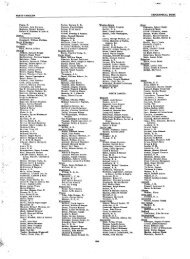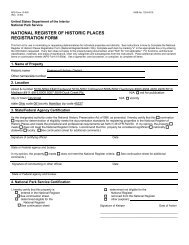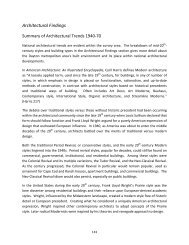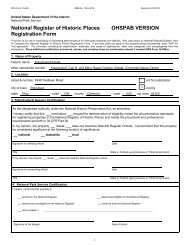National Register of Historic Places Registration Form
National Register of Historic Places Registration Form
National Register of Historic Places Registration Form
Create successful ePaper yourself
Turn your PDF publications into a flip-book with our unique Google optimized e-Paper software.
Southington Local School District Campus<br />
Name <strong>of</strong> Property<br />
Trumbull County<br />
Ohio<br />
County and State<br />
Beginning in the early 1960s, the consolidation <strong>of</strong> small, localized school districts was seen by state<br />
administrators as more efficient and economical to operate. As a result, many <strong>of</strong> Southington’s comparably<br />
sized neighboring communities combined their schools; in 1968, Bloomfield and Mesopotamia Townships<br />
merged their districts. To the south <strong>of</strong> Southington, Braceville consolidated with Warren Township<br />
(Leavittsburg) in 1970 to create the LaBrae school district. Later, in 1988, Farmington and Bristolville, to the<br />
north <strong>of</strong> Southington consolidated as well. Further northeast, Kinsman, Gustavus, Hartford and Vernon<br />
Townships merged schools to form Joseph Badger school district. A portion <strong>of</strong> Mecca, Greene and Johnstown<br />
Townships merged to form Maplewood Local, the southern portion <strong>of</strong> Mecca and Bazetta comprise Lakeview<br />
Local, and Mathews Local consists <strong>of</strong> Vienna and Fowler Townships. (Figure 3) <strong>Historic</strong>ally, strong local<br />
support for property tax levies and a deep seated sense <strong>of</strong> community has enabled Southington’s school to<br />
remain independent.<br />
This intact campus is representative <strong>of</strong> the response <strong>of</strong> Southington Township to changing demographics<br />
expressed by an increasing population and student enrollment. It reflects the evolution <strong>of</strong> the site from when the<br />
citizens voted to centralize their isolated one-room neighborhood schoolhouses in 1905, added the stylish Tudor<br />
inspired elementary building in the prosperous 1920s, initiated PWA aided modernization during the<br />
Depression and accommodated the phenomenal growth and development <strong>of</strong> the region through the 1940s, 50s<br />
and 60s.<br />
The site retains sufficient essential physical features, despite some alterations, to convey its association with the<br />
evolution <strong>of</strong> Southington’s educational system over the past one hundred years. The striking Chalker High<br />
School Building and distinguished 1906 elementary building flank the Civil War Monument, reflecting the<br />
exact design envisioned by Newton Chalker. Later additions illustrate the natural evolution <strong>of</strong> a growing<br />
community and school system.<br />
________________________________________________________________________________________________________________________<br />
Developmental history/additional historic context information (if appropriate)<br />
The first permanent settlers in the portion <strong>of</strong> the Connecticut Western Reserve that would become Southington<br />
Township were Luke Viets and his wife, James Chalker, his wife and two children, and Roderick and Horace<br />
Norton all from Litchfield County, Connecticut on 1805. They were soon joined by more settlers, also mostly<br />
from Connecticut. The first school term in Southington is said to have been ca. 1814 in a double-log home<br />
located about three quarters <strong>of</strong> a mile southeast <strong>of</strong> the center <strong>of</strong> the Township.<br />
By 1817, the Township had been organized into nine election districts, which also served as individual school<br />
districts for the community. In 1824, the first attempt to organize and fund the construction <strong>of</strong> a permanent<br />
school was made. Thirty <strong>of</strong> the original settlers pledged from between one and eight days labor to help<br />
construct a schoolhouse at one <strong>of</strong> two places, either the center <strong>of</strong> Southington Township or at another nearby<br />
location. This first attempt apparently did not yield enough commitment, because a second petition was<br />
formed. This petition contained pledges <strong>of</strong> not only labor, but material as well. In around 1825, a log<br />
schoolhouse was built near the center <strong>of</strong> the township, later replaced by a non-extant brick building. 20 As<br />
additional settlers populated the township, localized one-room schoolhouses were built as needed in the nine<br />
township school districts. The only known one that remains is now used as the community Town Hall, situated<br />
on a lot adjacent to and northeast <strong>of</strong> the Southington school campus.<br />
In general, development <strong>of</strong> the township was slow in comparison to other nearby communities. Factors that<br />
inhibited robust development included a lack <strong>of</strong> water, limited railroad access and the close proximity to<br />
20 H. Z. Williams, History <strong>of</strong> Trumbull and Mahoning Counties. Vol. II, (Cleveland, 1882) p. 523-524.<br />
18






